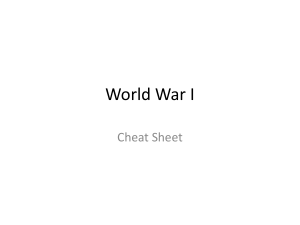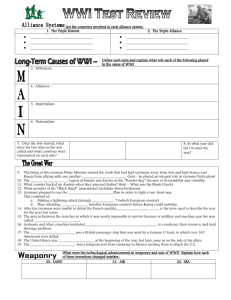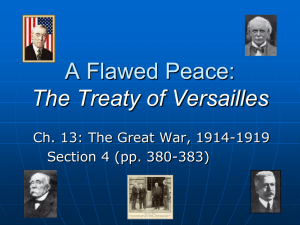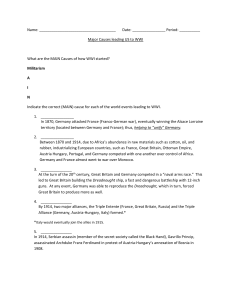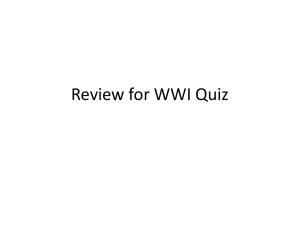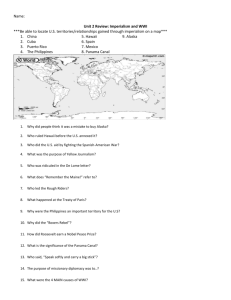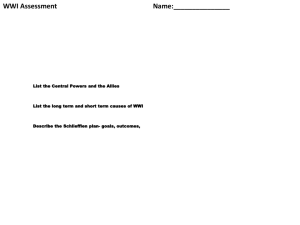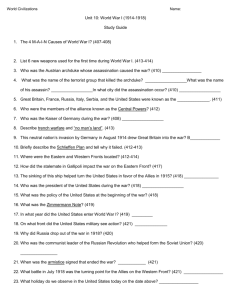I. WWI
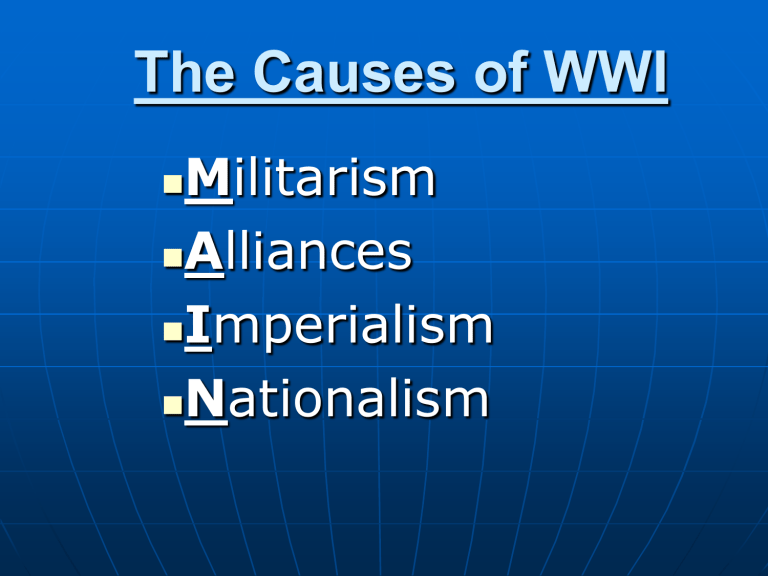
The Causes of WWI
Militarism
Alliances
Imperialism
Nationalism
WWI: The Great War
Causes
1.
Imperialism:
France, Great
Britain, Russia,
Germany
• Kaiser Wilhelm II
• Industrialization
Germany can compete through “blood and iron”
Kaiser Wilhelm II
Kaiser Wilhelm II
Built up German army and navy
Aggressive foreign policy
Determined to make
Germany a top nation.
Distrusted by other powers
“Germany must have its place in the sun”
“The world belongs to the strong.”
2.
Militarism
• Define: build up of armed forces
1890: Germany has strongest military
Militarism
Germany was competing with the UK to build battleships.
The British feared an attack on their Empire
Germany was competing with Russia and France to expand their armies
3.
Alliance System
•Triple Entente: France, Great
Britain, and Russia
•Triple Alliance: Germany,
Austria-Hungary, Ottoman Empire
•Global security
Balance of power
Imperialism caused many countries to form alliances
Alliance Structure
Alliances tested
Archduke Franz Ferdinand
June 28 1914- assassinated
Black Hand-Serbian Nationalists
Gavrillo Princip is the assassin
July 28, 1914: Austria-Hungary declares war on Serbia
• Russia is allied with Serbia
• Germany is allied with Austria-Hungary
August 1: Germany declares war on
Russia
• Russia is allies with France
August 3: Germany declares war on
France
• Great Britain is allies with France
• Great Britain immediately declares war on Germany……..WWI has BEGUN!!!!
Nationalism + Imperialism=
Extreme hatred for other nations
Causes build-up of arms
Battles of WWI begins
August 4, 1914
•Germany invades Belgium
Schlieffen Plan
Hold off Russia, ATTACK France
• Start in Belgium, drive to Paris
Once France falls, German forces focus on Russia
Trench Warfare: fortified ditches
“No Mans Land”
Early fighting=stalemate
Britain’s Reaction
1838- UK had signed a
Treaty to protect Belgium.
Britain also scared of
Germany controlling
Channel ports.
Did not want Germany to defeat France and
dominate Europe. Britain next?
UK issued ultimatum to
Germany to withdraw troops from Belgium. War declared August 4 1914
World War I Assignment
1. On a sheet of poster paper, create a poster of the causes of WWI.
Include key facts about each cause.
Include key countries, individuals, and vocabulary
Use textbook and notes as a resource
Use Coloring Pencils or Markers
2. On a sheet of poster paper, create a timeline of the events preceding WWI.
Include key countries, individuals, vocabulary
Include declarations of war and reasons for those declarations.
Key Ideas of WWI
Mobilization- The gathering and movement of troops for war
Isolationism- A policy of nonintervention into intercontinental violence
Pacifists- Opposed war and violence as a mean of diplomacy
Monroe Doctrine- Europeans were no longer to interfere with American affairs
Protectionism- The theory of protecting domestic markets by placing tariffs and quotas on imports
American Neutrality
1914- why fight?
Opposition to the war
• Sympathy for Germany
• Sympathy for Allies
Germany=Imperial Bully
Economics
U.S. enters the war
• British Blockade: prevent contraband
Reasons we couldn't remain neutral:
1.
2.
Friendship with France and G.B.
British propaganda had large influence
3.
Economic ties to European nations
• Allies depended on U.S. supplies
• Economic boom in the U.S.
1916, he ordered a major defense buildup
National Defense Act: called for a larger army and a navy second to none most people still favored peace though
Wilson campaign: “man who had kept the nation out of war”
German U-Boats
•Counter to blockade
•Any ship is fair game
No warning needed
•Lusitania: British liner
Sank by U-boat
128 Americans killed
Americans are furious
America still neutral: Wilson wants peace
1916: Germany breaks promise
•Sussex: unarmed French passenger boat
Attacked by German U-boat
• 80 people killed
U.S. issues another warning
Zimmermann Note: British intercepts message
•Germany asks Mexico to declare war on U.S.
•Mexico would gain Texas, New
Mexico, and Arizona
•U.S. enters war: make world
“safe for democracy”
..\World Civilization\Zimmerman
Telegram.doc
American war effort
April 1917: U.S. officially in war
200,000 men in army----Draft or Recruit?
Selective Service Act: men required to register for military
• Set minimum draft age of 18
• Resulted in 3 million draftees
U-boat resistance
• Convoy System: merchant ships provided defense
American troops fresh
Gearing up for War
U.S. was short on supplies
Pres. Wilson created War Industries
Board to organize the country for war
• Increased production & controlled limited resources
Railroad Administration— organized all
RR lines into one network that serviced the entire nation
Shipping Board— oversaw the building of a merchant marine
Gained govt. support thru increased taxes & war bonds
Feeding the Allies
Food Administration Board— headed by Herbert Hoover
• Controlled food production & distribution
• Top needs were wheat, pork, & sugar
• Americans were encouraged to cut back to save cost
• Volunteered to participate in saving techniques
• (Wheatless Mondays, Meatless Tuesdays,
Porkless, Thursdays & Saturdays)
Children grew vegetables on playgrounds
People planted "victory gardens" in their backyards
Wartime Propaganda
Committee on Public Information- Wilson
• 75,000 men spoke around the country
• were called "Four Minute Men"
• War was fought for democracy & freedom
• Those criticizing the war were treated poorly, sometimes beaten
Espionage Act (1917)—fines & jail sentences for aiding the enemy or blocking recruitment
Sedition Act (1918)--punished those using disloyal or abusive language about the
American govt., flag, or military uniforms
1,500 citizens lost their civil liberties
People were arrested for everything from criticizing the draft & the Red Cross to complaining about taxes
Replacement soldiers
•General Pershing: “old glory”
Separate army
Russia drops out of war
April 1918: U.S. independent army
New weapons: tanks, poison gas, airplanes
•War is mechanized
Germany collapses
•Mutiny amongst the soldiers
•Rebellion in Berlin
•November 11, 1918 at 11:00:
Germany surrenders
26 million total deaths
•Russia- 9 million
•Germany- 7 million
•U.S.- 325,000
Post-war
Fourteen Points
•II. Absolute freedom of navigation upon the seas
•XIV. A general association of nations must be formed
League of Nations: provide national security without war
“Big Four”:
•Woodrow Wilson- United States
•Georges Clemenceau- France
•David Lloyd George- Gr. Britain
•Vittorio Orlando- Italy
“Make Germany pay”
Treaty of Versailles
•Germany must pay for war: $28 billion in total
German military:
•100,000 soldiers
•no airplanes
•no submarines
War Guilt Clause: Germany must take responsibility for starting the war
Humiliation---Adolf Hitler uses
Treaty of Versailles as a rallying cry for Germany prior to WWII
End of the War
Treaty of Versailles- Made Germans accept reparations (compensation to cover war damages) worth 132 billion gold marks = $28 Billion Dollars) Initial sum of 50 billion gold marks was 330% of national income from previous year
^^^^^^^^^^^^^^^^^^^^^^^^^
Main cause for World War II
Opposition to treaty
•Too much imperialism
•Too harsh on Germany
U.S. never ratifies Treaty of
Versailles or joins League of
Nations
Opposition in Congress: Henry
Cabot Lodge
November 11, 1918 @ 11 am
•The date to end the war.
Changes in America
Industry jobs increase
•Wages increase
Food conservation:
•“Victory Gardens”
Women in workforce
Civil liberties
•Espionage and
Sedition Acts
U.S. Economics of WWI
United States economy was in a recession prior to 1914
Recession- Period of reduced economic activity
United States economy improved following start of war and the sale of goods to Europe- Agriculture and
Industrial equipment
Following World War I, the United
States was member in the international market
Military: 1917: 200,000
1918: 4.5 million
Total labor: 1916: 40 million
1918: 44 million
Financing the war
•Raise taxes
•Borrow from public (war bonds)
•Print money (Uh-Oh!)
